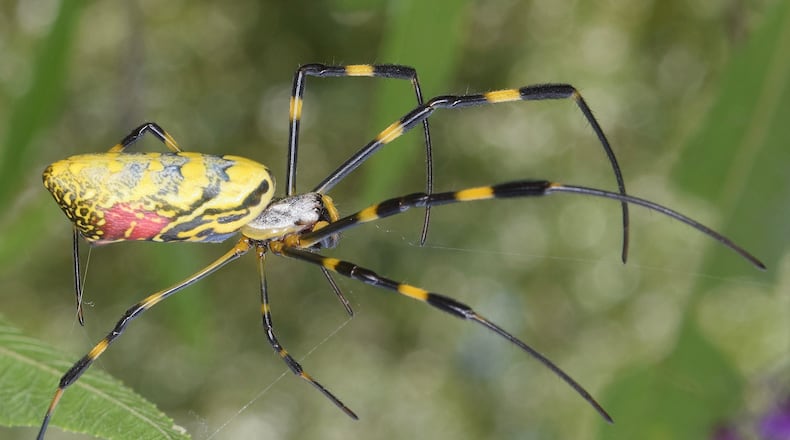Spiders the size of a human palm, bee-eating hornets and toxic worms.
Georgia’s diverse ecosystems are home to a huge range of native species, but over the years, some unwanted animals and plants from as far away as Japan have made their way the Peach State. While some are just odd to look at, others pose major risks to native species and to the state’s economy.
Here are some of the most notable invasive species that have arrived in Georgia.
Yellow-legged hornet (Vespa velutina)
Credit: Danel Solabarrieta
Credit: Danel Solabarrieta
The yellow-legged hornet — a species native to Southeast Asia that preys on honeybees and other pollinators — was discovered in Georgia earlier this year. A specimen was spotted in early August near Savannah by a beekeeper, marking the first-ever confirmed detection of the species in the wild in the U.S.
Georgia Department of Agriculture officials are actively working to eradicate the pests, which officials have warned could pose a grave threat to the state’s agriculture industry. Experts from the University of Georgia have estimated that Georgia’s pollinator-dependent crops are worth $430 million annually.
Joro spider (Trichonephila clavata)
Credit: TNS
Credit: TNS
The Joro spider is native to Japan, but the species turned up in Georgia in 2014.
The yellow, blue-black and red spiders are most notable for their size — the insects can measure nearly 3 inches across when their legs are fully extended. Despite their alarming appearance, experts say they’re not a danger to humans and have little impact on local food webs or ecosystems.
Shovel-headed worm (Bipalium kewense)
Credit: Special
Credit: Special
The shovel-headed worm, a snake-like creature that can grow to nearly a foot long, has been found in the U.S. for roughly a century, but there have been increased sightings in Georgia in recent years.
The worms have a distinctive half-moon-shaped head with a yellowish-brown body and a stripe down the middle of their backs. The creatures also secrete a dangerous neurotoxin through their skin, and should not be handled if spotted.
Blue land crab (Cardisoma guanhumi)
Credit: Courtesy of DNR
Credit: Courtesy of DNR
Blue land crabs, a species native to warmer climates further South, have been spotted along the Georgia coast in recent months.
The crustaceans live most of their lives on land and have historically been found in coastal areas from South America to South Florida. They can grow as large as 5-6 inches across and have one pincer larger than the other.
The crabs are edible and are legal to harvest in Florida from November to June. But their extensive burrowing could pose a risk to Georgia’s native wildlife, Georgia Department of Natural Resources (DNR) officials have warned.
Kudzu (Pueraria montana var. lobata)
Dubbed the “vine that ate the South” for its rapid growth and propensity to swallow entire forests, kudzu is among the most notable invasive species found in Georgia.
The plant is native to Japan and southeast China, but was introduced to the U.S. in the late 1800s to help control erosion and provide a forage crop for cattle. But the vine soon spread out of control and now covers millions of acres of land across the Southeast.
Argentine black and white tegus (Salvator merianae)
Credit: TNS
Credit: TNS
Reaching up to 4 feet long and weighing around 10 pounds, the Argentine black and white tegu is another unwelcome arrival to the Peach State from South America.
In recent years, Georgia DNR has warned that a population of the massive lizards has established itself in Toombs and Tattnall counties in south Georgia. The tegus feed on the eggs of ground-nesting birds and other native reptiles, and can be a vector for potentially dangerous parasites and bacteria.
Nine-banded Armadillo (Dasypus novemcinctus)
Easily identified by the bony plates that cover its back, the invasive nine-banded armadillo is now found in all 159 of Georgia’s counties.
Originally from Central and South America, the armadillo is considered an exotic pest in Georgia and can transmit diseases like leprosy to humans, though infections from the animals are very rare. Their foraging behavior is also harmful to Georgia’s native plants.
About the Author
Keep Reading
The Latest
Featured










